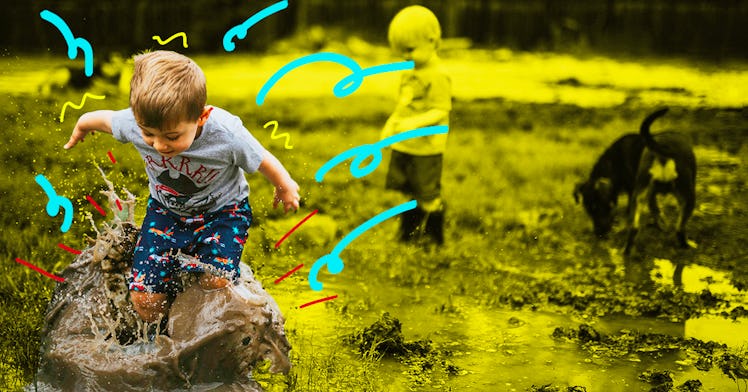Why Your Backyard Needs a Mud Kitchen ASAP
Mud kitchens allow kids to make, squish, and experience mud. More importantly, they help them explore their imaginations and thrive in summer.

Mud kitchens combine the practicality of play sets with the tactile satisfaction of mud pies. It’s a classic summer kid’s activity, revitalized by Instagram and its inherent pragmatism for families who want to avoid the playground.
So what is a mud kitchen? It’s basically a play kitchen outfitted for the backyard so kids can use it to create dirt and water concoctions. Whether built from scratch or made from an existing kitchen play set, mud kitchens are an excellent way to entertain kids — and have a greater benefit than preserving landscaping and corralling a messy outdoor activity. Mud play encourages mindfulness, builds fine motor skills, and promotes imaginative play, the latter of which is a major component of how kids make sense of their experiences.
“Kids learn and process their feelings about the world through imaginary play,” says Katie Lear, a licensed counselor and play therapist in North Carolina. “It helps them make sense of the world around them, experiment with taking on new roles, and provides a safe outlet for discharging negative feelings like anger and aggression.
How to Build a Mud Kitchen
While it is true that the only necessary parts of a mud kitchen are some dirt, some water, and maybe a bucket, part of the appeal of pretend play in a mud kitchen is, well, something that looks like a kitchen. Mud Kitchens are easy to build — or reconstruct — really requiring only a drill. But you can buy one too. Whether store-bought or hand-made (and plenty of plans and tutorials are available online), top-notch mud kitchens share some common characteristics:
- A water source (from a hose connection, hand pump, or gravity-fed tap);
- A sink (repurposed from a remodel or the ReStore adds the luxury of a drain);
- A counter with a backsplash (it’s just a workspace – plywood scraps or pallet wood is fine, as long as it is smooth);
- Utensils for shaping, molding, and mixing (measuring cups, buckets, old pots, and pans);
- Shelves or hooks for those utensils to make it feel like a kitchen – and make it easier to keep tidy after play.”
Mud: “Nature’s Prozac”
While this is true of imaginative play in general, outdoor play in general – and specifically playing in the mud, has some unique benefits.
“There’s an interesting study from the University of Bristol that found that mud contains a type of bacteria that increases serotonin production in the brain, leading to an improved sense of wellbeing,” explains Lear. “I don’t think kids are drawn to mud because it’s nature’s Prozac, but we do know that outdoor play benefits kids in all kinds of ways, such as helping them develop motor skills and increasing their exposure to different textures and sensory input.”
Tactile play is important for kids, as the recent slime craze confirms. In small children, it seems as though it can directly promote brain growth.
“Sensory play can help kids develop fine motor skills that they’ll need for tasks like writing in school,” Lear says. “There’s also evidence that suggests sensory-rich play can help build neural connections in the brain, which can enhance learning.”
Squishy and Soothing: The Beauty of a Mud Kitchen
Sensory play can also be a very calming activity for kids who may be feeling anxious during the pandemic
“I find that sensory play can be very grounding and soothing to kids, allowing them to focus more and attend to other tasks more effectively,” explains Lear.
Part of that may be due to how a mud kitchen fully engages the senses, Lear says. “Mud play is an immersive experience that helps kids to really focus on what’s happening with their five senses: the mud may be cool in temperature; it has a distinct feel; it smells earthy; it makes great noises. Many mindfulness practices encourage attunement with the senses as a way of staying in the present moment. When you think about sensory play through this lens, it’s really pretty sophisticated.”
And since this kind of play is unstructured – anything goes in a mud kitchen, after all – it’s perfect letting kids work through their experiences. “Kids can let their creativity be their guide, allowing them to focus on whatever they need to process at the moment and giving them a sense of control and mastery in an otherwise out-of-control world,” explains Lear.
This is an opportunity for kids that they don’t get to take very often. Structure is important to a child, and routines should be maintained even when there’s no school. But so is the kind of wild joy of directionless tactile play, which kids normally don’t get very often.
“Even before the pandemic, so much of kids’ lives took place in a pretty sterile environment: there isn’t a lot of sensory input in most classrooms,” Lear says.
So let the kids play in the mud. Let them leave footprints across the balcony. Maybe, instead of memories of uncertain times, they’ll remember this as the year of the long summer.
This article was originally published on